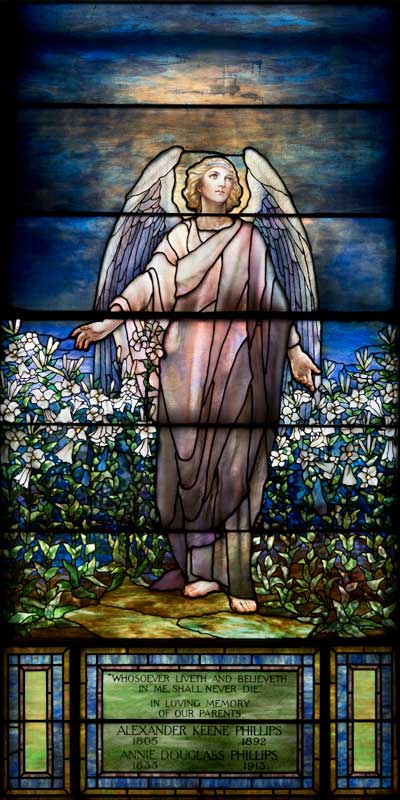
Stained Glass Windows— “Angel of the Resurrection”, 1914, Tiffany
The following window is the second on the right or southern side.
The stained glass windows along the sides of the nave were added between 1907 and 1917 except for one in 1943. This was the era of Louis Comfort Tiffany He patented opalescent glass which acquired a much wider range of tonalities, textures, densities, and lines by using chemicals. We have 3 Tiffany windows which are part of this tour.
The first, “Angel of the Resurrection is an Easter window. The scripture occurs just before Palm Sunday
“Whosoever Liveth and Believeth In Me, Shall Never Die” John 11:24-26. This was the chapter on the Raising of Lazarus. Martha, Mary, and Lazarus were part of the same family in Bethany near Jerusalem. There are at least 3 scripture references to the family.
Jesus is speaking with Martha in Bethany, consoling her over the death of her brother Lazarus and trying to connect the resurrection with the present. (Of course, Jesus will raise Lazarus from the dead.)
“Martha saith unto him, I know that he shall rise again in the resurrection at the last day. Jesus said unto her, I am the resurrection, and the life: he that believeth in me, though he were dead, yet shall he live: And whosoever liveth and believeth in me shall never die. Believest thou this?”
Louis Tiffany
Tiffany explored the pictorial, coloristic, and textural qualities of stained glass. Tiffany called his brand Favrile Glass since the color was embedded or ingrained in the glass. It was a uniquely American phenomenon that proved to be among the most important advances in decorative windows.
Favrile glass, also known as opalescent glass was created in the glassmaking by alternating heating and cooling of the glass and with the addition of chemical additives to create the desired effect. It has a milky, opaque and sometimes rainbow-hued appearance when light shines through it.
In this window, the angel is standing in the field of snow-white lilies, clad in robes of pink. The windows show Tiffany’s work in drapery glass for the angel’s robes that are close to fabric folds. Tiffany’s use of glass plays well with the sun which strikes the window in the morning hours. It accentuates the paint and enamel to the face and hands. The yellow-streaked, sun-dappled clouds are a dawn sky, a common metaphor for rebirth. The opalescent glass was used in the skies.
Another use of glass is fractured glass in the flowers. Fractured glass is embedded glass with tiny paper-thin flakes in different colors. It was made by breaking vessels blown thin, spreading the shards on a marver and embedding them into the molten glass. These multicolored, irregularly shaped fragments produced visually complex effects, which were perfect for representing foliage. Typically this glass was used for landscapes.
A final technique is the use of jewel-like objects in the flowers. These are pieces of hot glass that are press-molded into a jewel-like shape.